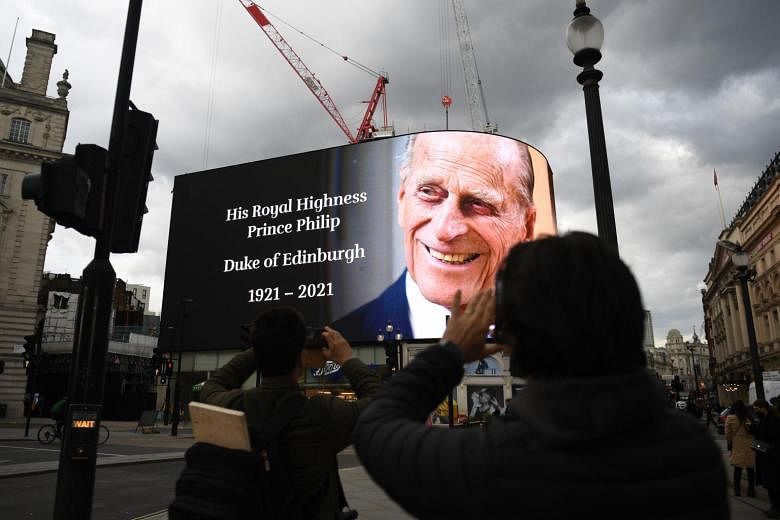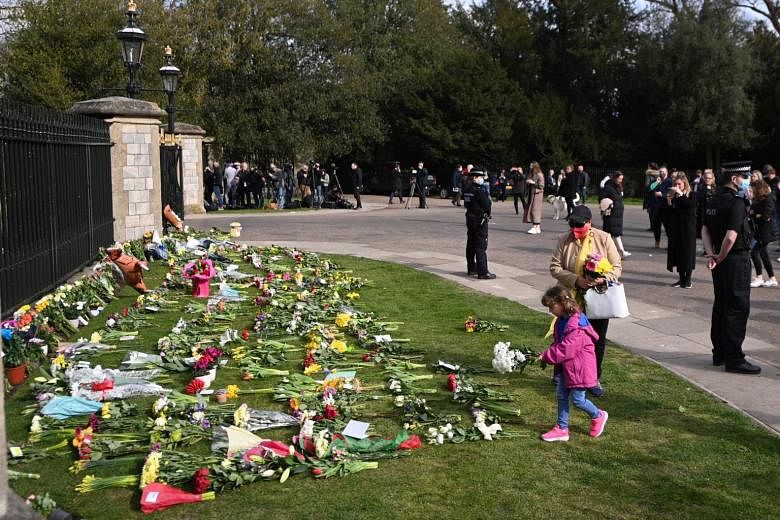LONDON (BLOOMBERG, REUTERS) - Prince Philip, Duke of Edinburgh, husband and confidant of Britain's Queen Elizabeth II since 1947, has died. He was 99.
"It is with deep sorrow that Her Majesty the Queen announces the death of her beloved husband, His Royal Highness Prince Philip, Duke of Edinburgh," according to an e-mailed statement on Friday (April 9) from the Queen's officials. "His Royal Highness passed away peacefully this morning at Windsor Castle."
He had only recently been hospitalised and underwent a successful heart procedure.
Prince Philip's death comes at a moment of profound change for the royal family, amid Prince Harry's departure from royal duties and the controversy over Prince Andrew's friendship with convicted sex offender Jeffrey Epstein. At the same time, Britain is trying to heal the wounds resulting from its departure from the European Union and is riven by deep political and social divisions.
The duke was one of the hardest-working members of the British royal family. He has powered through various health scares over the years, retiring from public life only towards the end of his life.
A former Royal Navy officer and World War II veteran, Prince Philip was required by protocol to walk two paces behind his wife in public. But he successfully carved out a role for himself, tirelessly touring coal mines, hospitals, tiddlywinks championships and sheep shows. He accompanied his wife on more than 250 official overseas visits, meeting heads of state around the world.
He also guarded his independence and drove himself as much as possible until he turned over his Land Rover on a country road in January 2019, leaving a woman with a broken wrist. He was persuaded to give up his driver's licence but was spotted later in the year driving a horse-drawn carriage on a road near the Queen's Norfolk country estate.
The College of Arms said on Friday that the duke will not have a state funeral nor lie in state for the public to pay their respects ahead of the funeral.
"The funeral will not be a State Funeral and will not be preceded by a Lying-in-State. His Royal Highness's body will lie at rest in Windsor Castle ahead of the funeral in St George's Chapel. This is in line with custom and with His Royal Highness's wishes," the College of Arms said.
"The funeral arrangements have been revised in view of the prevailing circumstances arising from the Covid-19 pandemic and it is regretfully requested that members of the public do not attempt to attend or participate in any of the events that make up the funeral."
Personal legacy
The duke never attended university, having joined the Royal Navy straight from school, but was passionately committed to education. His legacy includes the Duke of Edinburgh's Award project, a personal-development programme for young people, and he was made chancellor for life of the University of Cambridge.
He was perhaps most famous for speaking his mind in public. His politically incorrect gaffes amused, and sometimes appalled, the nation. While the Queen managed never to offend anyone in public, her husband was followed wherever he went by tabloid journalists on "gaffe watch".
He was able to laugh at his own mistakes, once joking about "dontopedalogy" or "the science of opening your mouth and putting your foot in it". He said he had been "practising it for years". The duke's supporters contended that his comments were usually bad attempts at humour, as when he asked a blind woman with a guide dog: "Do you know they have eating dogs for the anorexic now?"
The duke's forthright manner sometimes led to strained relations with members of his family, particularly Prince Charles, his eldest son and the heir to the throne. In 1994, Prince Charles told his authorised biographer that his father had bullied him into marrying Lady Diana Spencer.
The couple divorced in 1996, after 15 years of marriage. Diana died in a car crash in Paris the following year. Many in Britain felt the royal family, and the duke in particular, had treated Diana poorly.
In November 2002, Prince Philip issued a public statement following media reports that he had written insulting letters to Diana at the time of her break-up with Prince Charles. The reports were a "gross misrepresentation" of his relationship with the princess, he said.
The duke had a close relationship with the next generation. Prince William described him as a "legend" and his grand daughter Eugenie said Prince Philip held the family together.
"He really is strong and consistent," she told a TV documentary. "He's the rock, you know, for all of us."
Turbulent childhood
The man who went on to marry the longest-reigning British monarch had a turbulent childhood. He was born Prince Philippos of Greece and Denmark on June 10, 1921, on a kitchen table at Villa Mon Repos, a summer house on the Greek island of Corfu.
At his birth, Greece was experiencing political upheaval. In September 1922, his uncle, Greece's King Constantine, was forced to abdicate by republicans who resented his pro-German leanings and his dismissal of a popular prime minister.
A revolutionary court sentenced Prince Philip's father to death, though the punishment was not carried out, and the British sent a Royal Navy ship to evacuate the Greek royals. The family fled with the 18-month-old Philip in a cot made from an orange box. Greece was declared a republic two years later.
Prince Philip spent his early childhood in Paris, where he became fluent in French. His mother had a nervous breakdown in 1930 and was diagnosed as a paranoid schizophrenic. She was confined to mental institutions for most of the next decade and, during World War II, returned to Greece, where she became a nun. His father moved to Monte Carlo and his four sisters went to stay with German relatives.
War service
As war with Germany loomed in 1939, Prince Philip enrolled as a cadet at the Britannia Royal Naval College in Dartmouth, south-west England.
Two years later, while serving on the battleship HMS Valiant, he won praise from superiors for bravery after a night-time sea battle off Cape Matapan in southern Greece. Prince Philip was in control of searchlights that illuminated enemy Italian ships.
In July 1943, he was second-in-command of the destroyer HMS Wallace and took part in the Allied landings on Sicily. The prince was on board the destroyer HMS Whelp just off Japan when the Japanese officially surrendered on Sept 2, 1945.
During his time at sea, Prince Philip corresponded with the young Princess Elizabeth, whom he called by the pet name Lilibet.
They had first met in July 1939, when she visited Dartmouth with her family. She was a shy 13-year-old, he an 18-year-old Royal Navy cadet. They were distantly related, both great-great-grandchildren of Queen Victoria.
The future queen's governess, Marion Crawford, later wrote that Prince Philip was "rather like a Viking with a sharp face and piercing blue eyes. He was good looking, though rather off-hand in his manner. Lilibet never took her eyes off him the whole time".
In July 1947, the couple announced their engagement amid concern among some courtiers about Prince Philip's foreign roots. In an effort to fit in, he changed his family name from Schleswig-Holstein-Sonderburg-Glucksburg to the more English-sounding Mountbatten, an anglicised version of his mother's surname, Battenberg.

He renounced his own royal title as a prince of Greece and Denmark in order to become a naturalised British subject and converted from the Greek Orthodox religion to Anglicanism.
Britain's King George VI bestowed on his new son-in-law the titles His Royal Highness Duke of Edinburgh, Earl of Merioneth and Baron Greenwich. The wedding took place on Nov 20, 1947, in London's Westminster Abbey.
The bridegroom's German relatives were not invited. Three of his sisters had married German aristocrats in the 1930s. One was photographed sitting opposite Adolf Hitler at the wedding of Nazi Reich Marshal Hermann Goering, the commander of Germany's Luftwaffe.

Churchill's advice
There was also debate over the issue of what name the royal family should use. The queen, on advice from wartime Prime Minister Winston Churchill, decided she would not take her husband's name, Mountbatten, and would remain Windsor. It was an important issue for the duke, who later said he felt like he had been "turned into an amoeba".
The married duke continued to serve in the Royal Navy and became a commander with his own ship, while also performing royal duties with his wife. In 1952, the couple were in Kenya when George VI died. It was the duke who broke the news to his wife that she was now Queen Elizabeth II.
He also ended his naval career, deciding he could not fully support his wife while spending long periods away at sea. At a banquet celebrating their golden wedding anniversary in 1997, the monarch publicly thanked her husband.
"He has quite simply been my strength and stay all these years," she said.



